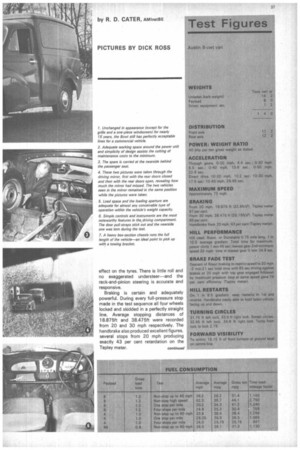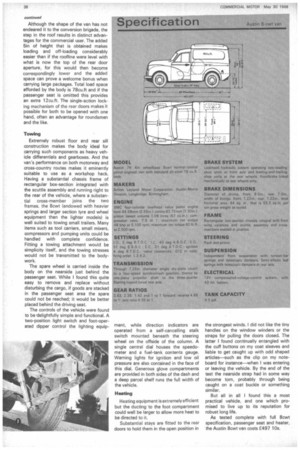AUSTIN 8-CWT VAN
Page 38

Page 39

Page 40

If you've noticed an error in this article please click here to report it so we can fix it.
WHEN the Morris 5cwt van was introduced in July 1953 it was heralded as a considerable step forward in light commercial vehicle design. When an example was tested by Commercial Motor later that year, the technical editor, L. J. Cotton, commented: "Mechanically the van is an excellent example of modern design and engineering. It is a vehicle which has the appearance of withstanding the efforts of those who are unskilled or have little knowledge of the art of driving". Sixteen years later, that judgement is still largely relevant.
Over the years the Morris 5cwt has been uprated, first to 6cwt and more recently, by the provision of heavier springs and larger tyre equipment, to 8cwt. During a recent test the latest version of the van, now designated the Austin 6-8cwt and powered by the BMC 1098cc A-series engine, showed that it is still an adequate competitor to other vehicles in its field. It returned excellent fuel consumption results, and demonstrated that its roadholding and braking power were completely unaffected by the 60 per cent heavier payload it now carries.
Reliability and simplicity of maintenance are two of the vehicle's main attributes. But throughout the test—which covered some 650 miles and virtually every type of going—the performance showed time and again that the design was in fact just as Cotton had said "an excellent example". After completing a fully laden journey which included some 400 miles of motorway at near maximum speeds and just on 120 miles of Pennine roads plus the traversing of two major cities, the vehicle returned overall average speed and consumption figures of 38.2mph and 35.8mpg.
Despite numerous attempts by the makers to discontinue the model, widespread popularity of the car version has ensured the continued production of both car and van. My one serious criticism of the vehicle is that to which attention was directed in the first CM report—rearward vision. I find it hard to understand why, after all this time, it has not been found desirable either to enlarge the rear windows or re-site the interior mirror so that the dangerous blind spot created by the centre division of the rear doors is avoided. The exterior mirrors would have more acceptably overcome this disadvantage if they had been of a more suitable type and better sited Those on the test vehicle were too far inboard and, with flat glasses, of very little use.
During performance tests only the four-stops-per-mile and full-throttle exercises pulled the consumption down to below 30 mpg. Fully laden at a steady 40 mph, but not with freak driving, 36.7 mpg was returned.
Acceleration was very brisk indeed, the 1,098 cc engine whipping the vehicle up to 20 mph in only 4.4sec., while 30 and 40 mph were reached in 8.5 and 13.6sec respectively. The top-gear capability of the machine makes it ideal for working in dense traffic. It will pull comfortably in top from 15 mph upwards with a complete absence of fuss or judder from the transmission. Considering that the engine thrives on commercial grade petrol and produces such lively acceleration, an almost unparalleled flexibility and an ability to maintain a comfortable 70mph over really long distances one has to admit that this basically 20-years-old design (it was based on the Morris Minor of 1948) still ranks with the best available today.
Roadholding Roadholding, when I first collected the vehicle, could have been better and indeed was considerably improved after I increased the rear tyre pressures from 25 to 30 psi. Until then the van was inclined to yaw quite badly above 40 mph. Increasing the tyre pressures cured the problem completely and despite high cross-winds on MI I did not experience any further difficulty.
The ride when laden was a little hard judged by 1969 standards but at no time could it be described as uncomfortable or in fact likely to damage even delicate cargoes. Its firmness and stability when cornering will be particuarly appreciated if the driver happens on a corner tighter than he expected, for, unlike some vehicles I have driven, turning the steering wheel on the Austin 8cwt results in the vehicle going round the corner, with nothing more than a rather punishing effect on the tyres. There is little roll and no exaggerated understeer-and the rack-and-pinion steering is accurate and responsive.
Braking is certain and adequately powerful. During every full-pressure stop made in the test sequence all four wheels locked and skidded in a perfectly straight line. Average stopping distances of 18.875ft and 38.475ft were recorded from 20 and 30 mph respectively. The handbrake also produced excellent figures, several stops from 20 mph producing exactly 43 per cent retardation on the
Tapley meter. continued
continued
Although the shape of the van has not endeared it to the conversion brigade, the step in the roof results in distinct advantages for the commercial user. The added 5in of height that is obtained makes loading and off-loading considerably easier than if the roofline were level with what is now the top of the rear door aperture, for this would then become correspondingly lower and the added space can prove a welcome bonus when carrying large packages. Total load space afforded by the body is 78cu.ft and if the passenger seat is omitted this provides an extra 12cu.ft. The single-action locking mechanism of the rear doors makes it possible for both to be opened with one hand, often an advantage for roundsmen and the like.
Towing Extremely robust floor and rear sill construction makes the body ideal for carrying such components as heavy vehicle differentials and gearboxes. And the van's performance on both motorway and cross-country routes makes it eminently suitable to use as a workshop hack. Having a substantial chassis frame of rectangular box-section integrated with the scuttle assembly and running right to the rear of the vehicle, where a substantial cross-member joins the two frames, the 8cwt (endowed with heavier springs and larger section tyre and wheel equipment than the lighter models) is well suited to towing small trailers. Many items such as tool carriers, small mixers, compressors and pumping units could be handled with complete confidence. Fitting a towing attachment would be simplicity itself, and the towing stresses would not be transmitted to the bodywork.
The spare wheel is carried inside the body on the nearside Just behind the passenger seat. While I found this quite easy to remove and replace without disturbing the cargo, if goods are stacked in the passenger seat area the spare could not be reached; it would be better placed behind the driving seat.
The controls of the vehicle were found to be delightfully simple and functional. A two-position light switch and foot-operated dipper control the lighting equip ment, while direction indicators are operated from a self-cancelling stalk switch mounted beneath the steering wheel on the offside of the column. A single central dial houses the speedometer and a fuel-tank contents gauge. Warning lights for ignition and low oil pressure are also contained in the face of this dial. Generous glove compartments are provided in both sides of the dash and a deep parcel shelf runs the full width of the vehicle.
Heating Heating equipment is extremely efficient but the ducting to the foot compartment could well be larger to allow more heat to be directed to it.
Substantial stays are fitted to the rear doors to hold them in the open position in the strongest winds. I did not like the tiny handles on the window winders or the straps for pulling the doors closed. The latter I found continually entangled with the cuff buttons on my coat sleeves and liable to get caught up with odd shaped articles—such as the clip on my noteboard for instance—when I was entering or leaving the vehicle. By the end of the test the nearside strap had in some way become torn, probably through being caught on a coat buckle or something similar.
But all in all I found this a most practical vehicle, and one which promised to live up to its reputation for robust long life.
As tested complete with full 8cwt specification, passenger seat and heater, the Austin 8cwt van costs £497 10s.












































































































